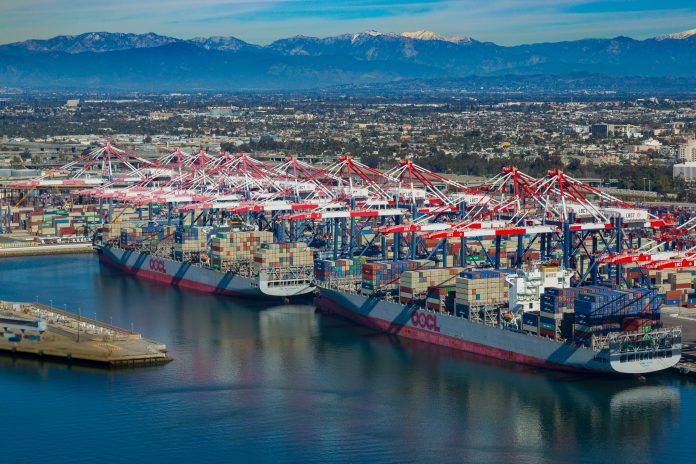Uncertainty is affecting the Atlantic trade as the election rhetoric ramps up, and we approach the deadline for employers and US East Coast dockers to reach a contract agreement.
Rates on the Atlantic have fluctuated over this year as shippers seek to avoid the worst effects of the Red Sea diversion, which has seen capacity redeployed from the Atlantic to both the Pacific and Asia/Europe trades.
The effects of the Red Sea diversions on the Atlantic trade were seen immediately with rates from the Med leaping from under US$1,500/FEU to nearly US$2,250/FEU in February this year. And a similar effect was seen in North European rates which soared from US$1,875/FEU to US$2,250/FEU in the same month, according to Xeneta figures.
Today rates for north European export cargo to the US stand at US$2,750/FEU and US$2,250/FEU from the Mediterranean, a year-on-year increase of 64.68% and 43.73% respectively, said Xeneta.
However, Atlantic volumes have had a limited effect on the rates according to Container Trades Statistics (CTS) CEO Nigel Pusey: “US, Canada and European volumes on the Atlantic remain constant and largely unaffected by the Red Sea conflict – volumes and freight rates have seen little knock on from general box shortages in other geographies.”
Increases in cargo volumes cannot account for all these rate increases, however, with North American export volumes, including the US and Canada, up 12.39%, 113,180 TEUs, in the seven months to July 2024, amounting to 1.026 million TEUs, compared to 912,894 TEUs in the same period last year, according to data from CTS.
Meanwhile North American imports increased 5% from 2.079 million TEUs to 2.183 million TEUs, an increase of 103,786 TEUs in the same period, said CTS.
In part, rate changes are thought to be caused by an early peak, but there has also been an increase in the redeployment of tonnage, with the Ocean Alliance leading the way.
French carrier CMA CGM had five Atlantic services in mid-2023, three alliance rotations, all to the US, with 15 vessels totalling 83,000 TEUs. By mid-2024 that had declined to four services, three alliance loops to the US, with eight vessels totalling 55,000 TEUs.
Its alliance partner Evergreen has not operated a vessel on the Atlantic since July when the Ever Living was withdrawn and entered the Asia trades, and is not due to return to the Atlantic until 1 November.
MDS Transmodal data shows that Evergreen does not currently have tonnage on the trade, but offers US East Coast services via its Ocean Alliance partners. Evergreen and CMA CGM are by no means alone in the shift of tonnage out of the Atlantic trades, with MDS Transmodal statistics showing an 18.6% drop in aggregated capacity year-on-year, to 872,630 TEUs, from 1,071,537 TEUs.
Interestingly CMA CGM’s redeployment of vessels has mainly been to the Pacific, which has seen a 5% increase the carrier’s capacity deployed, compared to just 0.7% on the Asia/Europe trade.
Concern now turns to the 1 October when the East Coast dockers are due to begin industrial action should negotiations with employers break down.
Dynamar analyst Darron Wadey said the National Retail Federation/Hackett Associates Global Port Tracker is forecasting imports into the US to increase by 14% year-on-year in September to 2.3 million TEUs, reported Wadey, as shippers bring shipments forward.
Mainly driven by imports from Asia, although transatlantic shipments, with the Europe export leg being the dominant direction, will play a subsidiary role, he said.
He went on to say: “Undoubtedly, the carriers will have contingencies in place [to maintain services] – a ready-made playbook if you will.”
Meanwhile, Xeneta chief analyst Peter Sand warned that “Everybody doing business with the US should feel concerned,” after Tuesday’s election debate between Donald Trump and Kamala Harris.
Tariffs will increase 20% across the board if Trump is elected and by between 60% and 100% for freight out of China.
Sand, however, also pointed to the Biden/Harris administration, which maintained tariffs introduced by Trump in his first term, and there is no expectation that those barriers to trade will be lifted, or that a Harris presidency would not increase the protectionism implied by these import duties.
It is this kind of uncertainty that is killing trade, according to Xeneta who claim that tariff levels under Harris would be “different”, “The fact that we don’t know what tariffs to expect causes uncertainty,” said Sand, and means “Everybody doing business with the US should feel concerned.”
Mary Anne Evans
Correspondent at Large







